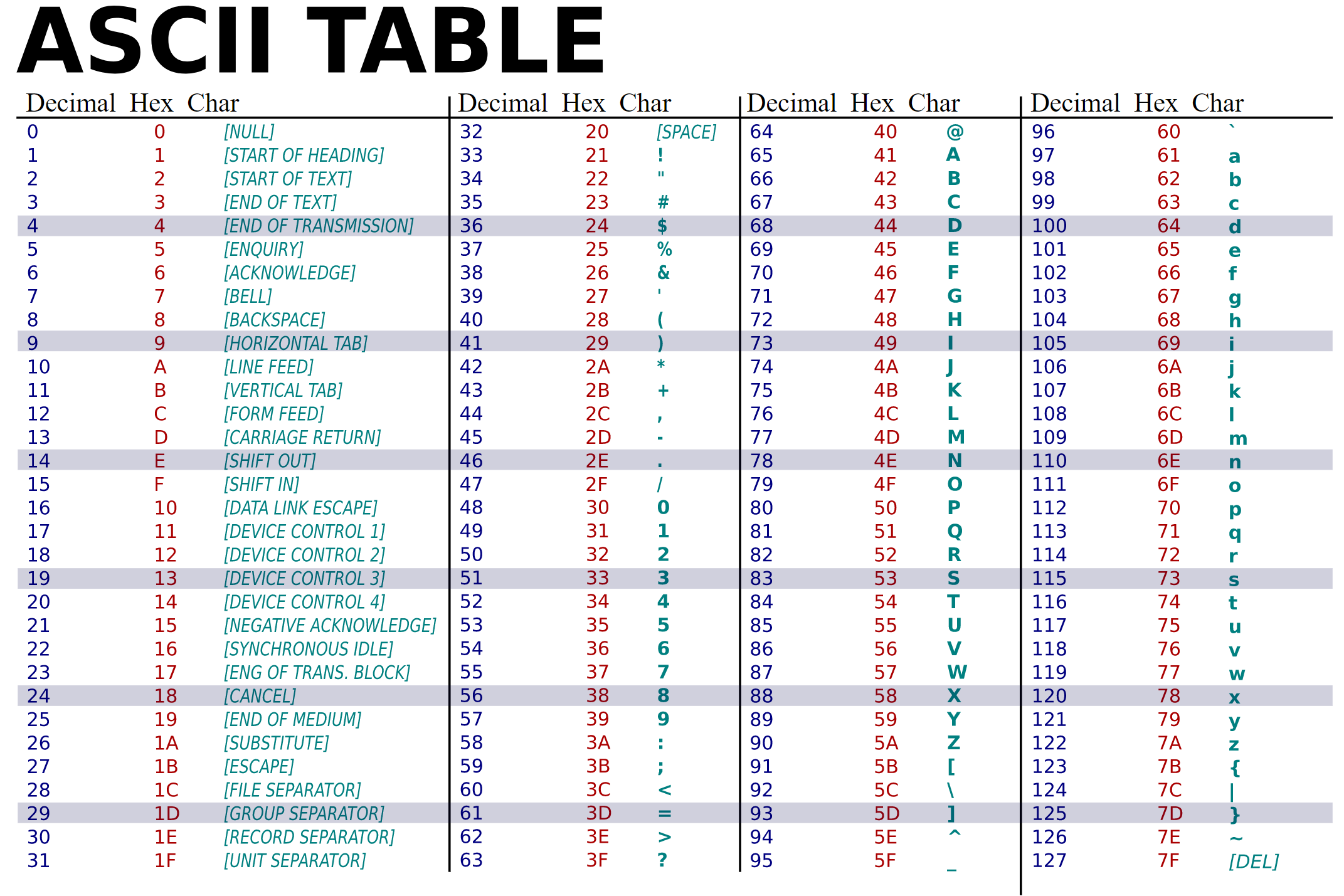What is ASCII?
ASCII (pronounced "ask-ee") stands for American Standard Code for Information Interchange. It's a character encoding standard that assigns numeric values (0-127) to letters, numbers, punctuation marks, and control characters.
ASCII is the foundation of text representation in computers and has been the backbone of digital communication since the 1960s.
Quick Facts
- Full Name: American Standard Code for Information Interchange
- Pronunciation: ASK-ee
- Character Range: 0-127 (7-bit encoding)
- Extended Range: 128-255 (8-bit, non-standard)
- First Published: 1963
- Current Standard: ANSI X3.4-1986, RFC 20
- Use Case: Text representation, data transmission, programming
ASCII Character Ranges
0-31: Control Characters
Non-printable characters used for text control and communication.
- NULL (0): Null character
- LF (10): Line feed (newline)
- CR (13): Carriage return
- ESC (27): Escape
- DEL (127): Delete
32-126: Printable Characters
Standard visible characters including letters, numbers, and symbols.
- 32-47: Space and punctuation
- 48-57: Digits 0-9
- 65-90: Uppercase A-Z
- 97-122: Lowercase a-z
- Special chars: !@#$%^&*() etc.
128-255: Extended ASCII
Non-standard extended characters (varies by implementation).
- International characters
- Special symbols
- Box-drawing characters
- Not part of standard ASCII
- Implementation-dependent
History of ASCII
How ASCII Works
ASCII uses 7 bits to represent 128 different characters. Each character is assigned a unique decimal number from 0 to 127, which can also be expressed in binary, octal, or hexadecimal.
Decimal: 65 | Binary: 01000001 | Octal: 101 | Hex: 41
Common ASCII Values
| Character | Decimal | Hex | Description |
|---|---|---|---|
| Space | 32 | 0x20 | Space character |
| 0 | 48 | 0x30 | Digit zero |
| A | 65 | 0x41 | Uppercase A |
| a | 97 | 0x61 | Lowercase a |
| LF | 10 | 0x0A | Line feed (newline) |
ASCII in Programming
ASCII is fundamental to programming. Most programming languages provide functions to convert between characters and their ASCII values.
Examples in Different Languages
ASCII vs. Unicode
| Feature | ASCII | Unicode (UTF-8) |
|---|---|---|
| Characters | 128 (7-bit) | 1,114,112+ characters |
| Languages | English only | All world languages |
| Size | 1 byte per character | 1-4 bytes per character |
| Compatibility | Limited to Latin alphabet | Backward compatible with ASCII |
| Emojis | Not supported | Fully supported 😀 |
Practical Applications
- Text Files: Plain text files (.txt) typically use ASCII or UTF-8 encoding
- Programming: Source code files are often ASCII or ASCII-compatible
- Data Transmission: Email, HTTP, and many protocols use ASCII
- Terminal/CLI: Command-line interfaces rely on ASCII characters
- CSV Files: Comma-separated values typically use ASCII
- Configuration Files: Many config files use ASCII encoding
Fun Facts About ASCII
- The difference between uppercase and lowercase letters in ASCII is always 32 (e.g., 'A' = 65, 'a' = 97)
- This makes case conversion in ASCII very efficient with bitwise operations
- The '@' symbol was almost removed from ASCII but was kept due to its use in email addresses
- ASCII was designed with a focus on telecommunications and early computer systems
- The layout of ASCII was designed to make sorting and comparison operations efficient
- Control characters (0-31) were designed for teletype machines and early terminals
ASCII Art
ASCII art is a creative use of ASCII characters to create images and designs. It was particularly popular in the early days of computing when graphical displays were limited.
___ _____ _____ ___ ___ / _ \ / ____/ ____|_ _|_ _| | |_| | (___| | | | | | | _ |\___ \ | | | | | | | | |____) | |___ | |_| |_ |_| |_|_____/ \____|___|___|
Visual Reference

(Image Credit: WikiMedia ASCII-Table.svg: ZZT32derivative work: LanoxxthShaddow [Public domain])
Related Standards
- Extended ASCII: 8-bit extensions (128-255) - not standardized, varies by code page
- ISO 8859-1 (Latin-1): Western European extension of ASCII
- UTF-8: Variable-width Unicode encoding, ASCII-compatible
- UTF-16: 16-bit Unicode encoding
- UTF-32: 32-bit Unicode encoding
Further Reading
- Browse the complete ASCII table - Interactive table with all ASCII characters
- ASCII Code Converter - Convert between characters and codes
- ASCII Art Gallery - Explore creative ASCII artwork
- RFC 20: Official ASCII specification (IETF)
- ANSI X3.4-1986: Current American National Standard